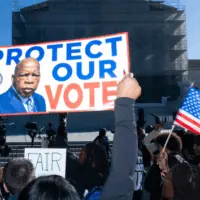
(WASHINGTON) — The Supreme Court on Wednesday appeared ready to limit how a key part of the Voting Rights Act long aimed at protecting equal opportunity for racial minority voters is applied to the drawing of state election maps.
During oral arguments in a complicated case challenging the drawing of a second majority-black district in Louisiana, the court’s conservative majority suggested race may have improperly predominated as a factor in its creation.
At the same time, it was not clear whether a majority of the court was prepared to issue a more sweeping ruling that any use of race as a factor in redistricting is unconstitutional.
Section 2 of the Voting Rights Act has long been a guardrail against states “packing” Black voters into districts and “cracking” communities of color into other districts with an aim of diluting their electoral influence.
Courts that have found a violation of Section 2 then order states to redraw their maps, with an eye on race, to ensure minority voters are given fair chance at political participation.
The law does not require proof of intent to discriminate — prohibiting any discrimination in effect — but several conservative justices suggested that plaintiffs should have to show at least some possibility of intent, a tougher standard to meet.
Justice Brett Kavanaugh, who could be the key vote in the case, voiced particular concern about the indefinite use of race to draw maps compliant with Section 2.
“This court’s cases in a variety of contexts have said that race-based remedies are permissible for a period of time, sometimes for a long period of time, decades in some cases, but that they should not be indefinite and should have an end point,” Kavanaugh said.
“What is not grounded in case law,” replied Janai Nelson, president and director-counsel of the NAACP Legal Defense Fund, which is defending Louisiana’s map, “is the idea that an entire statute should somehow dissolve simply because race may be an element of the remedy.”
The court’s longstanding precedents have said that race cannot be a primary motivating factor when drawing congressional districts under the equal protection clause of the 14th Amendment, but they also grant states have breathing room to consider race in order to comply with the Voting Rights Act.
The court most recently upheld Section 2 in a 2023 decision.
“What Section 2 does is to say where the effects [of a congressional map] are discriminatory such that … African Americans here are not being given the same voting opportunities as white people are, then a remedy is appropriate,” Justice Elena Kagan told Louisiana Solicitor General Benjamin Aguinaga. “That remedy doesn’t have to be race-based, but sometimes it is race-based in order to correct the racially discriminatory situation that exists.”
Justice Ketanji Brown Jackson most vigorously defended the legacy of Section 2 and its use to create two majority-black districts in Louisiana, describing the Civil Rights-era law as a “tool” to identify racial disparities.
“It’s like a tape measure that we’re looking [at] as to whether or not certain circumstances exist, and those circumstances that Congress is worried about – unequal access to electoral opportunity,” she said. “That’s why it doesn’t need a time limit, because it’s not doing any work other than just pointing us to the direction of where we might need to do something.”
Justice Samuel Alito said outright that he believed lower courts did not correctly apply the Supreme Court’s precedents around Section 2 to the maps at issue in Louisiana.
“There’s a serious question about whether the Black population within the district in question in the illustrative map was geographically compact,” he said, referring to one of the legal requirements for a VRA-compliant map.
A decision in Louisiana’s favor could, at the very least, require the state to redraw its map under more race-neutral criteria ahead of the 2026 midterm election. The two majority-black districts are represented by Democrats.
A broader conclusion in the case could upend congressional maps nationwide, potentially triggering the redrawing of race-neutral districts in multiple states and in turn putting minority representation at risk in legislatures nationwide.
Nelson argued that a further rollback of the Voting Rights Act would be “catastrophic.”
“If we take Louisiana as one example, every congressional member who is Black was elected from a VRA opportunity district,” she said. “We only have the diversity that we see across the south, for example, because of litigation that forced the creation of opportunity districts under the Voting Rights Act.”
The court is expected to release a decision before the end of its term in June 2026. How quickly it releases its ruling could determine whether or not states will have sufficient time to redraw maps — if necessary — before midterm voting begins.
Copyright © 2025, ABC Audio. All rights reserved.














